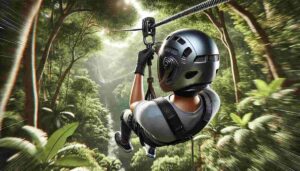The thrill of soaring through the air at high speeds while suspended on a cable has made zip lining a popular adventure activity. Zip lines are now found in various locations, from commercial zip line tours to backyard setups. However, to ensure your safety, it’s crucial to use high-quality zip line kits that meet industry standards.
In this guide, I will explore everything you need to know about zip line kits, from their components and types to choosing the right kit, installation, maintenance, and safety tips. Whether you’re planning to build a backyard zip line or want to try zip lining for the first time, this guide will equip you with the necessary information to make an informed decision.
What is a Zip Line Kit?
A zip line kit is a set of components that are used to create a zip line. A typical kit includes a cable, trolley or pulley, braking system, harness or seat, and other necessary hardware such as anchors, clamps, and bolts. The cable is the main component of a zip line kit, and it is usually made of galvanized steel or a strong synthetic material like Kevlar or nylon. The trolley or pulley is attached to the cable and allows the rider to glide smoothly along the zip line. The braking system is essential for safety and typically consists of a bungee cord, braking block, or spring brake. Harnesses or seats provide support and safety for the rider, depending on the type of kit.
There are different types of zip line kits available, including backyard kits, commercial kits, and custom kits. Backyard kits are designed for home use and are typically shorter and have a lower weight capacity compared to commercial kits, which are used in zip line tours and other commercial operations. Custom kits are tailored to specific needs and can include features such as lighting, sound systems, and obstacle courses. Overall, a zip line kit is a complete package that contains all the necessary components to set up a zip line and have a safe and enjoyable ride.
Benefits of Using a Zip Line Kit
Using a zip line kit offers several benefits, including:
- Physical and Mental Benefits: Zip lining is an exhilarating adventure that provides physical exercise and can also help improve mental health. It promotes physical fitness, balance, and coordination, and enhances adrenaline and endorphin levels.
- Backyard Entertainment: A zip line kit is an excellent way to add an exciting and unique feature to your backyard. It provides hours of fun and entertainment for family and friends, and can also increase the value of your property.
- Cost-Effective Alternative: Zip line kits are a cost-effective alternative to commercial zip lines. They offer a great opportunity for homeowners and businesses to set up a zip line on their property at a fraction of the cost of a commercial zip line.
- Customizable: Zip line kits are available in different sizes, weight capacities, and designs, making them customizable to fit specific needs. Custom kits can be tailored to include various features, such as obstacles, lights, and sound systems.
- Eco-Friendly: Zip line kits are a relatively eco-friendly adventure activity. They do not require much energy to operate and are powered by gravity. Additionally, zip lines can be installed in natural settings without damaging the environment.
Overall, using a zip line kit is a great way to experience the thrill of zip lining while enjoying the benefits it offers.
Choosing the Right Zip Line Kit
When choosing a zip line kit, it’s essential to consider safety, quality, and durability. Here are 5 factors to consider when selecting the right zip line kit:
- Safety Considerations: Safety is paramount when selecting a zip line kit. Ensure that the kit meets industry standards, and all components are certified for safety. Look for a kit that includes a reliable braking system, sturdy anchors, and a harness or seat that is comfortable and fits correctly. Avoid using homemade or improvised zip line kits, as they may pose significant safety risks.
- Length and Weight Capacity: The length and weight capacity of the kit should match the intended use. For backyard kits, choose a length and weight capacity that suits the age, size, and weight of the riders. Commercial kits should have a higher weight capacity and be long enough to offer an enjoyable ride.
- Ease of Installation: Choose a kit that is easy to install and comes with clear instructions. Consider the terrain, location, and accessibility when selecting a kit. Backyard kits should be easy to set up and take down, while commercial kits may require professional installation.
- Terrain Considerations: The type of terrain where the zip line will be installed is an important consideration. Different terrains may require different kits, and it’s essential to choose a kit that is suitable for the location. For example, a kit designed for flat terrain may not be appropriate for hilly or mountainous areas.
- Customer Reviews and Ratings: Customer reviews and ratings can provide valuable insights into the quality and performance of the kit. Look for kits with high ratings and positive reviews from users who have experience with the kit.
Here’s how much you can expect to pay for a zip line kit.
Installing Your Zip Line Kit
Installing a zip line kit can be a challenging task, but with the right tools and instructions, it can be done safely and easily. Here are four steps for installing your zip line kit:
- Preparation and Tools Needed: Gather all the necessary tools and materials before starting the installation process. Tools may include a ladder, pliers, wrenches, a drill, and a level. Make sure the area where the zip line will be installed is clear of obstacles, and the landing area is free of debris.
- Step-by-Step Installation Instructions: Follow the manufacturer’s instructions provided with the kit carefully. Typically, the installation process involves attaching the cable to the anchors, installing the trolley or pulley, and attaching the braking system. Ensure that the cable is taut and level to prevent sagging, and avoid over-tightening, which can cause stress on the cable.
- Safety Precautions during Installation: Always wear appropriate personal protective equipment, such as gloves and safety glasses, when installing the kit. Secure the ladder to prevent it from slipping, and use a safety harness when working at heights. Avoid installing the zip line during wet or windy conditions, and never use a damaged or worn-out kit.
- Test Run: After installing the zip line kit, perform a test run to ensure that everything is working correctly. Test the braking system, check for any signs of wear or damage, and adjust the tension as necessary. Invite a friend or family member to test the zip line before using it yourself.
If you’re unsure about any aspect of the installation process, consult a professional for assistance.
Maintaining Your Zip Line Kit
Proper maintenance of your zip line kit is essential for safety and longevity. Here are some tips for maintaining your zip line kit:
- Regular Inspections and Maintenance: Inspect your zip line kit regularly, at least once every few months, and after each use. Look for signs of wear or damage on the cable, pulleys, anchors, and braking system. Tighten loose bolts and nuts and lubricate the pulleys as necessary.
- Common Issues and How to Troubleshoot Them: Common issues with zip line kits include cable wear, loose connections, and braking system malfunctions. Regular inspections can help identify these issues early on, and you can troubleshoot them by tightening loose connections, replacing worn-out parts, and adjusting the tension.
- When to Replace Parts or Upgrade Your Kit: Replace any worn-out or damaged parts promptly to prevent safety hazards. If you notice significant wear on the cable, consider replacing it entirely. Upgrading your kit to include additional safety features such as a backup braking system or a higher weight capacity may also be necessary as your usage and needs evolve.
- Proper Storage: Proper storage of your zip line kit can extend its lifespan. Store the kit in a dry and cool place away from direct sunlight, and avoid storing it in a tightly wound position.
Remember to consult the manufacturer’s instructions for specific maintenance guidelines and seek professional assistance if necessary.
Zip Line Safety Tips
Zip lining is an adventure activity that can be fun and exciting, but it also carries inherent risks. Here are six safety tips to ensure a safe and enjoyable zip line experience:
- Pre-Ride Safety Checklist: Before starting your zip line ride, check that all components, including the cable, pulleys, and braking system, are in good condition. Make sure that your harness or seat is properly fitted, and all connections are secure.
- Proper Attire and Equipment: Wear appropriate attire, including closed-toe shoes, comfortable and weather-appropriate clothing, and gloves to protect your hands. Use a helmet and safety harness or seat provided with the kit to ensure maximum safety.
- Riding Techniques for a Safe and Enjoyable Experience: Keep your feet up and avoid dragging them on the ground. Keep your hands away from the cable and pulleys during the ride. Avoid twisting or spinning, and always face forward.
- Safety Guidelines for Children and Pets: Ensure that children are supervised by an adult and are wearing appropriate safety gear. Pets should not be allowed on zip lines as they may panic and cause accidents.
- Weather Conditions: Avoid zip lining during wet or windy weather conditions, as these can affect the performance of the kit and increase the risk of accidents.
- Follow Rules and Regulations: If using a commercial zip line, follow the rules and regulations set by the operators. These may include age, weight, and height restrictions, as well as specific riding techniques.
Remember to always prioritize safety and avoid taking unnecessary risks.
Frequently Asked Questions (FAQs)
How do I know if a zip line kit is safe?
It’s essential to choose a kit that meets industry safety standards, and all components are certified for safety. Look for customer reviews and ratings and seek professional assistance if necessary.
What is the maximum weight limit for a zip line?
The maximum weight limit varies depending on the type of kit and its intended use. Backyard kits typically have a weight limit of around 250 to 300 pounds, while commercial kits can accommodate higher weight limits.
How long does it take to install a zip line kit?
Installation time depends on the type of kit and the complexity of the installation process. Backyard kits can take a few hours to install, while commercial kits may require professional installation and take longer.
Do I need any special skills to ride a zip line?
Riding a zip line does not require any special skills. However, it’s essential to follow safety guidelines and riding techniques to ensure a safe and enjoyable ride.
How often should I inspect my zip line kit?
Regular inspections are necessary to maintain the safety and longevity of your zip line kit. Inspect your kit at least once every few months and after each use, and address any issues promptly.
What type of maintenance does a zip line kit require?
Maintenance of a zip line kit may include regular inspections, tightening loose connections, lubricating pulleys, replacing worn-out parts, and proper storage.
What is the average lifespan of a zip line kit?
The lifespan of a zip line kit depends on various factors such as usage, weather conditions, and maintenance. Proper maintenance can extend the lifespan of your kit and ensure safety and functionality for many years.
Conclusion
Zip line kits offer a fun and exhilarating adventure activity that can be enjoyed by individuals of all ages. When choosing a zip line kit, safety should be the top priority, and it’s essential to select a kit that meets industry standards, has a reliable braking system, and sturdy anchors.
Proper installation and maintenance are also crucial for safety and longevity, and regular inspections can help identify issues early on. By following safety guidelines and riding techniques, you can ensure a safe and enjoyable zip line experience. With the right kit and precautions, zip lining can be a thrilling adventure that provides physical and mental benefits, backyard entertainment, and a cost-effective alternative to commercial zip lines.










